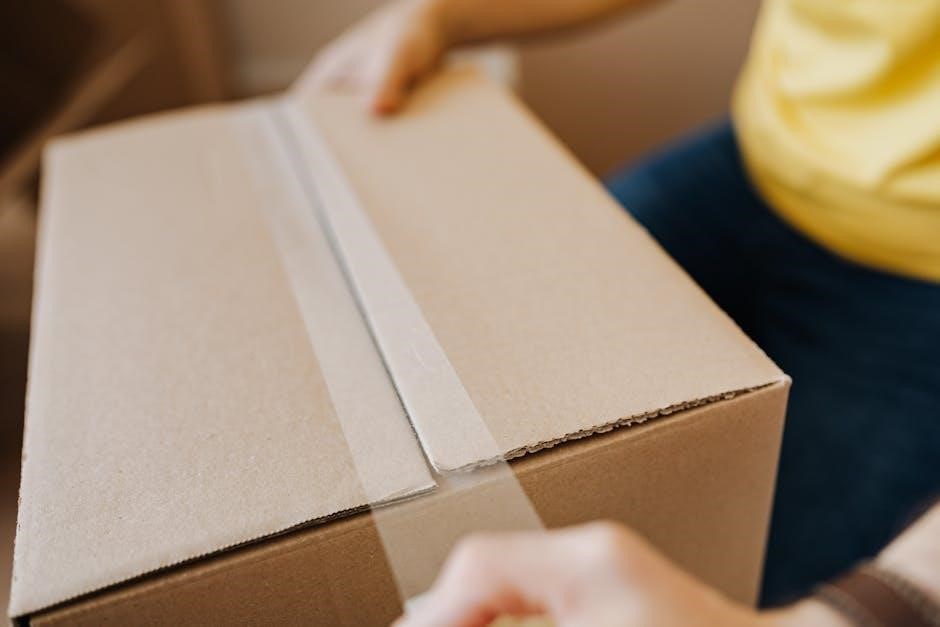
Taping is a widely used conservative treatment for plantar fasciitis, providing support, reducing pain, and improving foot biomechanics. It offers a non-invasive solution to alleviate symptoms effectively.
What is Plantar Fasciitis?
Plantar fasciitis is a common condition characterized by inflammation of the plantar fascia, a thick band of connective tissue supporting the arch of the foot. It causes sharp pain, typically near the heel, and is often worse with the first steps of the day. The condition arises from repetitive stress, overuse, or poor foot biomechanics, and can be exacerbated by factors like obesity, inadequate footwear, or prolonged standing. It is a leading cause of heel pain in active individuals and those with foot alignment issues.
Overview of Taping Techniques
Taping techniques for plantar fasciitis involve applying medical tape to support the foot and reduce stress on the plantar fascia. Common methods include Low-Dye taping, which off-loads the fascia, and kinesiology taping, which enhances blood flow. These techniques aim to provide arch support, improve biomechanics, and alleviate pain. They are often used alongside other treatments like stretching or orthotics for comprehensive care. Proper application is essential to maximize benefits and avoid discomfort or skin irritation.
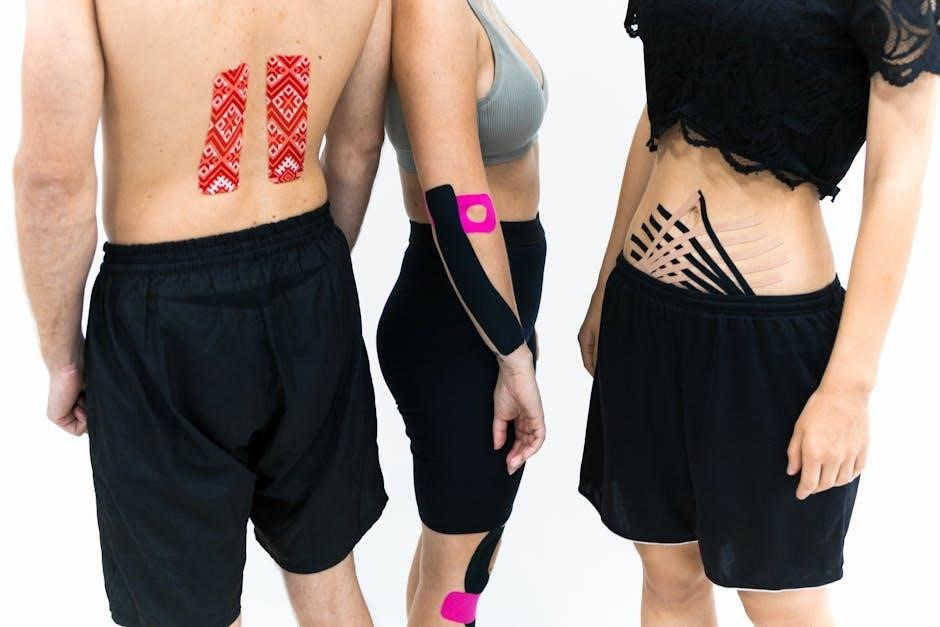
Benefits of Taping for Plantar Fasciitis
Taping provides immediate pain relief, reduces stress on the plantar fascia, and offers arch support. It improves foot biomechanics and enhances blood flow, aiding recovery and comfort.
Pain Relief and Support
Taping techniques provide immediate pain relief by redistributing pressure and reducing strain on the plantar fascia. The tape offers structural support, minimizing discomfort during activities. By stabilizing the foot, it helps alleviate sharp pains, especially during the first steps after rest. This support is crucial for individuals with severe symptoms, allowing them to maintain daily activities with reduced discomfort and improved mobility. The tape acts as a protective barrier, enhancing comfort and facilitating recovery.
Improving Foot Biomechanics
Taping helps correct abnormal foot mechanics by guiding proper alignment and movement patterns. Techniques like Low-Dye taping stabilize the foot, reducing excessive pronation or supination. This realignment decreases stress on the plantar fascia, promoting a more efficient gait. Improved biomechanics can prevent further injury and enhance overall foot function. The tape acts as a reminder to maintain proper posture, encouraging long-term positive changes in how the foot moves during daily activities and exercise, aiding in both recovery and prevention.
Enhancing Blood Flow
Taping can improve blood flow to the plantar fascia, promoting healing and reducing inflammation. Techniques like kinesiology taping create a mild lifting effect on the skin, enhancing lymphatic drainage and increasing circulation. Improved blood flow delivers oxygen and nutrients to the damaged tissue, accelerating recovery. This effect is particularly beneficial for chronic plantar fasciitis, where poor circulation may hinder healing. By stimulating blood flow, taping helps reduce swelling and supports the body’s natural repair processes, making it a valuable adjunct to other treatments.
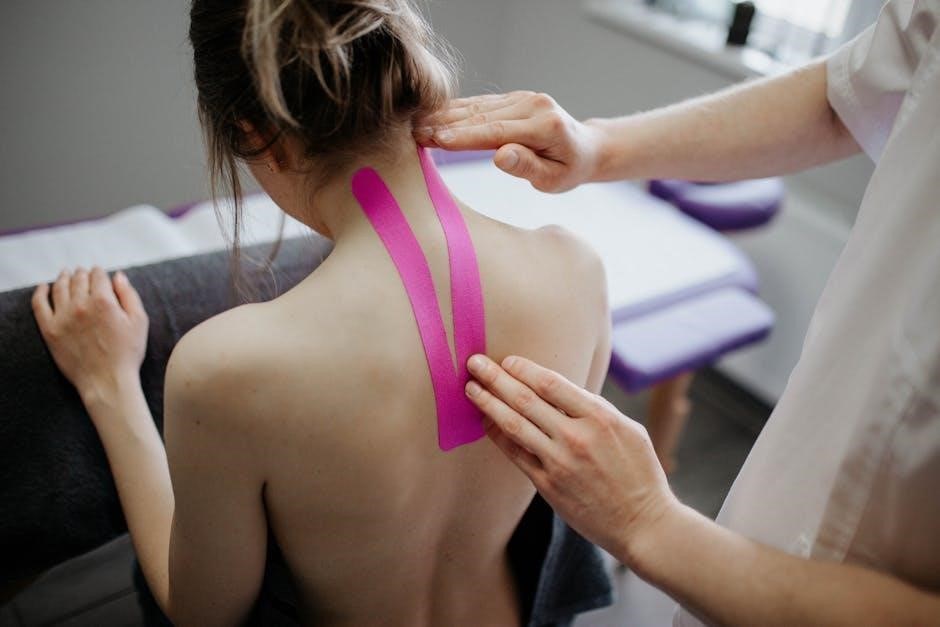
Popular Taping Techniques
Popular taping methods for plantar fasciitis include Low-Dye, Kinesiology, Windlass, and Calcaneal taping. Each technique offers unique support and pain relief benefits, addressing specific foot mechanics and symptoms.
Low-Dye Taping
Low-Dye taping is a widely recognized technique for plantar fasciitis, designed to reduce strain on the plantar fascia. It involves applying tape around the heel and arch, providing support and off-loading pressure. Studies show it effectively decreases pain, especially in the short term, and improves foot mechanics. This method is often recommended as a first-line conservative treatment due to its simplicity and effectiveness in alleviating symptoms and enhancing patient comfort during daily activities.
Kinesiology Taping (KT Tape)
Kinesiology taping (KT Tape) is a stretchy tape applied to support the foot’s natural arch and reduce plantar fascia strain. It promotes blood flow, alleviates pain, and enhances mobility. KT Tape is applied lengthwise along the bottom of the foot, providing gentle support without restricting movement. This technique is popular for its comfort and effectiveness in managing plantar fasciitis symptoms, making it a preferred choice for both athletes and individuals with daily discomfort.
Windlass Taping
Windlass taping involves wrapping the foot to create tension, which tightens the plantar fascia and reduces strain. This technique is applied by wrapping tape around the ball of the foot and extending it to the heel. It helps reduce stress on the plantar fascia, providing immediate pain relief and structural support. Windlass taping is particularly effective for alleviating morning pain and stiffness, making it a popular choice for managing plantar fasciitis symptoms effectively.
Calcaneal Taping
Calcaneal taping focuses on supporting the heel to alleviate plantar fasciitis pain. This method involves placing tape around the calcaneus, or heel bone, to reduce stress and inflammation. By stabilizing the heel, it helps distribute pressure more evenly across the foot, minimizing discomfort during movement. Calcaneal taping is often combined with other techniques for enhanced support and pain relief, making it a valuable approach in managing heel pain associated with plantar fasciitis effectively.
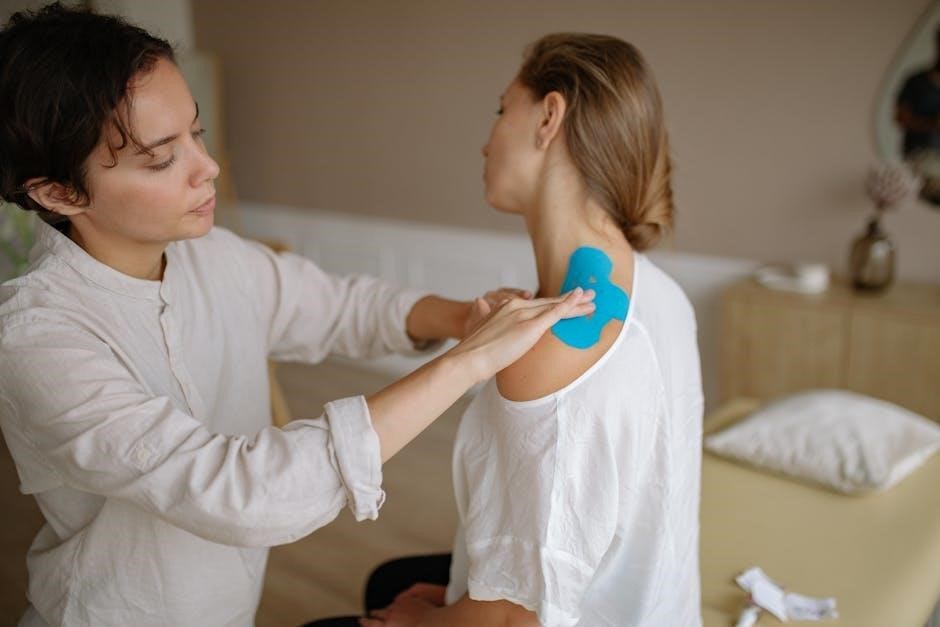
How Taping Works
Taping reduces stress on the plantar fascia by providing arch support and improving foot alignment. It helps redistribute pressure, easing pain and promoting proper foot function.
Reducing Stress on the Plantar Fascia
Taping techniques effectively reduce stress on the plantar fascia by redistributing pressure across the foot. This alleviates strain, particularly during activities like walking or running. By providing additional support, taping helps minimize the repetitive stress that contributes to inflammation and pain. The tape acts as an external stabilizer, allowing the fascia to heal while maintaining normal foot function. This method is both non-invasive and cost-effective, making it a popular choice for managing plantar fasciitis symptoms.
Providing Arch Support
Taping for plantar fasciitis often involves techniques that provide arch support, helping to maintain the natural shape of the foot. This support reduces strain on the plantar fascia, which can become overstretched. By stabilizing the arch, taping prevents excessive pronation or supination, common issues that exacerbate fascia irritation. The tape acts as a protective barrier, offering immediate relief and promoting proper foot mechanics. This support is especially beneficial during weight-bearing activities, aiding in the recovery and prevention of further injury to the fascia.
Altering Foot Mechanics
Taping techniques, such as Low-Dye and Kinesiology taping, are designed to alter foot mechanics by redistributing pressure and controlling excessive pronation or supination. This redistribution reduces strain on the plantar fascia, allowing it to heal; The tape provides structural support, guiding the foot into a more neutral position during movement. By modifying gait patterns and muscle activation, taping helps restore normal foot function, which is crucial for both symptom relief and preventing re-injury.

Step-by-Step Taping Guide
Prepare the foot by cleaning and drying the skin. Apply anchor points at the heel and ball of the foot. Use 80% stretch for the arch support, finishing without tension. Smooth the tape firmly to avoid wrinkles. Ensure the tape is snug but not restrictive. This method provides optimal support and pain relief, lasting up to five days. Proper application ensures effectiveness in reducing plantar fascia strain.
Preparation and Materials Needed
To begin, gather high-quality, non-stretch medical tape, sharp scissors, and optional antiseptic wipes. Clean and dry the foot thoroughly to ensure proper tape adhesion. Trim toenails if necessary to prevent irritation. Remove lotions or oils, as they may weaken the tape’s grip. Sit comfortably with the foot elevated to relax the plantar fascia. Ensure the skin is free of cuts or irritation before applying tape. Proper preparation ensures a secure, effective application for optimal support and pain relief.
Applying the Tape Correctly
Start by anchoring the tape at the heel, wrapping it around the foot with gentle tension. Apply the tape across the arch, ensuring no wrinkles form. Use an 80% stretch for optimal support. Point the toes upward during application to relax the plantar fascia. Finish by securing the tape on the outside of the foot without stretch. Avoid overtightening to prevent discomfort. Multiple strips may be applied for enhanced stability. Proper technique ensures effective pain relief and proper arch support, reducing strain on the plantar fascia.
Common Mistakes to Avoid
Common mistakes include overtightening the tape, which can cause discomfort or restrict movement. Applying the tape without proper preparation, such as cleaning the skin, can lead to poor adhesion. Incorrect tension or placement may reduce effectiveness. Avoid applying the tape too loosely, as it may not provide sufficient support. Overlapping too many layers can cause skin irritation. Ensure the foot is in the correct position during application, such as pointing toes upward, to maximize support for the plantar fascia. Proper technique is crucial for optimal results and comfort.
Effectiveness of Taping
Taping is effective for short-term pain relief and support in plantar fasciitis. Studies show techniques like low-Dye and calcaneal taping significantly reduce discomfort, offering immediate benefits for patients.
Short-Term Pain Relief
Taping techniques, such as low-Dye and kinesiology taping, provide immediate short-term pain relief for plantar fasciitis by reducing stress on the plantar fascia. These methods offer arch support, improving foot mechanics and alleviating discomfort during activities. Studies indicate a significant reduction in pain levels, making taping a viable option for quick symptom management. It is particularly beneficial for individuals seeking non-invasive solutions to manage flare-ups and improve mobility temporarily.
Long-Term Benefits
While taping primarily offers short-term relief, consistent use can contribute to long-term benefits by promoting proper foot mechanics and reducing chronic strain on the plantar fascia. Over time, this can lead to strengthened foot muscles and improved arch support, potentially reducing the frequency of flare-ups. Combined with other therapies like stretching and orthotics, taping can play a supportive role in managing plantar fasciitis effectively, aiding in overall recovery and preventing future episodes.
Comparison with Other Treatments
Taping is often compared to treatments like orthotics, physical therapy, and pain relief medications. Unlike these, taping is non-invasive, cost-effective, and easily applied at home. Studies suggest taping provides comparable short-term pain relief to orthotics and can enhance the effectiveness of other therapies when used together. However, it may not address the root cause as comprehensively as long-term physical therapy or medications, making it a valuable adjunct rather than a standalone solution for plantar fasciitis management.
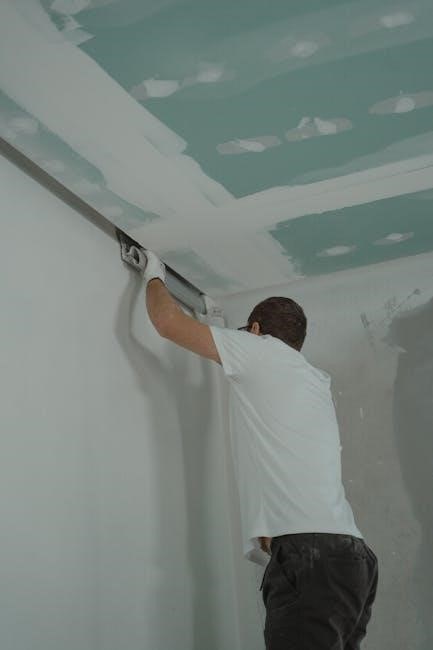
Combining Taping with Other Therapies
Combining taping with physical therapy, orthotics, and pain relief medications enhances treatment efficacy for plantar fasciitis, offering a comprehensive approach to managing symptoms effectively.
Physical Therapy and Stretching
Physical therapy and stretching are essential alongside taping for plantar fasciitis. Exercises like calf stretches and plantar fascia stretches improve flexibility and strength. Strengthening the intrinsic foot muscles enhances arch support, reducing strain on the plantar fascia. Manual therapy techniques, such as soft tissue mobilization, can also be incorporated to break up scar tissue and improve blood flow. Regular stretching routines, especially in the morning, help alleviate stiffness and pain, promoting long-term recovery and preventing recurrence.
Orthotics and Shoe Modifications
Orthotics and shoe modifications are complementary treatments to taping for plantar fasciitis. Custom orthotics provide arch support, redistributing pressure and reducing strain on the plantar fascia. Shoes with proper cushioning, arch support, and a rocker sole can also alleviate pain. Modifications like stretching the toe box or adding supportive insoles help accommodate orthotics and improve foot mechanics. Combining orthotics with taping enhances stability, promoting healing and preventing further injury. Proper footwear fit is crucial to avoid exacerbating symptoms and ensuring long-term relief.
Pain Relief Medications
Pain relief medications, such as nonsteroidal anti-inflammatory drugs (NSAIDs) like ibuprofen, can reduce inflammation and alleviate pain in plantar fasciitis. Topical creams or ointments containing NSAIDs or capsaicin may also provide localized relief. In some cases, corticosteroid injections or oral medications like acetaminophen are prescribed; These medications complement taping by addressing pain and inflammation, allowing the plantar fascia to heal more effectively. However, they should be used cautiously and under medical supervision to avoid side effects or dependency.
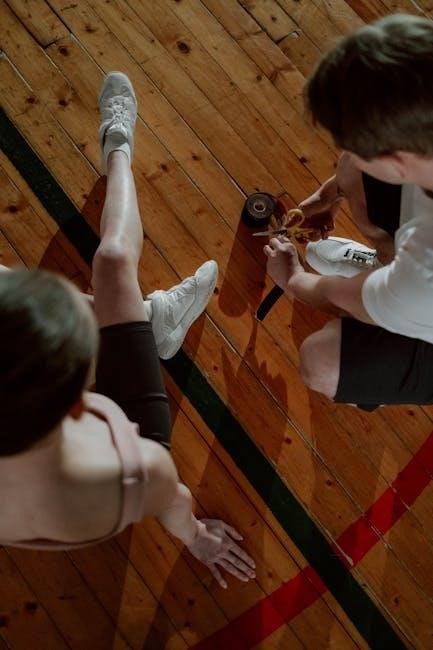
Potential Risks and Contraindications
Taping for plantar fasciitis may cause skin irritation or allergic reactions. Overreliance on taping can delay proper healing. Avoid taping if you have open wounds or severe inflammation.
Skin Irritation and Allergic Reactions
Taping for plantar fasciitis can cause skin irritation or allergic reactions, especially with frequent use. Some individuals may react to the adhesive or tape materials. Symptoms include redness, itching, or blistering. To minimize risks, use hypoallergenic tapes and avoid applying too much tension. Individuals with sensitive skin or history of allergies should test the tape on a small area first. If severe irritation occurs, discontinue use and consult a healthcare professional for alternative treatments.
Overreliance on Taping
Overreliance on taping for plantar fasciitis can hinder long-term recovery by masking symptoms without addressing root causes. While taping provides temporary relief, it should complement, not replace, treatments like stretching, orthotics, or physical therapy. Prolonged dependency may weaken foot muscles, reducing self-support capabilities. A balanced approach ensures taping aids recovery without creating dependency, promoting sustainable healing and preventing recurrence of plantar fasciitis symptoms.
When to Avoid Taping
Taping for plantar fasciitis should be avoided in cases of open wounds, severe foot deformities, or allergic reactions to tape. It is also not recommended if pain persists beyond initial relief or if taping causes further discomfort. Overreliance on taping without addressing underlying issues may delay recovery. Consult a healthcare professional if taping fails to provide relief or if symptoms worsen, as alternative treatments may be necessary for effective management of plantar fasciitis.
Case Studies and Success Stories
Real-Life Examples of Taping Success
Studies show significant pain reduction in patients using Low-Dye taping, with one trial reporting a 32mm decrease on a 100mm pain scale, demonstrating its effectiveness.
A study involving 51 patients reported a 32mm reduction in pain on a 100mm scale after using Low-Dye taping, highlighting its effectiveness. Another trial demonstrated significant symptom relief in athletes using kinesiology taping, allowing them to resume sports activities. These real-life examples show how taping can provide immediate and noticeable benefits for individuals with plantar fasciitis, improving their quality of life and ability to perform daily tasks without discomfort.
Studies Supporting Taping Efficacy
Multiple studies have demonstrated the effectiveness of taping for plantar fasciitis. Low-Dye taping has shown significant pain reduction, with one trial reporting a 32mm decrease on a 100mm pain scale. Kinesiology taping has also proven beneficial, improving symptoms and enabling athletes to resume activity. These findings underscore taping’s role as a valuable adjunct therapy, providing both short-term relief and functional improvement for individuals with plantar fasciitis.
Taping remains a beneficial treatment for plantar fasciitis, offering pain relief and support. Future research should explore innovative taping techniques to enhance long-term efficacy and patient outcomes.
Taping for plantar fasciitis provides immediate pain relief, reduces stress on the plantar fascia, and offers arch support. It improves foot biomechanics, enhances blood flow, and is non-invasive. Taping techniques like Low-Dye and kinesiology taping are effective for short-term symptom management. They are easy to apply and can be combined with other therapies for better outcomes. Taping is a cost-effective, first-line treatment option that promotes comfort and accelerates recovery, making it a popular choice among patients and healthcare professionals alike.
Emerging Trends in Taping Techniques
Emerging trends in taping for plantar fasciitis include advanced materials like elastic and breathable tapes, which enhance comfort and durability. Hybrid taping techniques combining Low-Dye and kinesiology methods are gaining popularity for improved efficacy. Additionally, eco-friendly and hypoallergenic tapes are being developed to cater to sensitive skin. Innovations in adhesive technology now allow tapes to last longer while maintaining therapeutic benefits. These advancements aim to provide more effective, personalized solutions for managing plantar fasciitis symptoms and improving patient outcomes.
Leave a Reply
You must be logged in to post a comment.